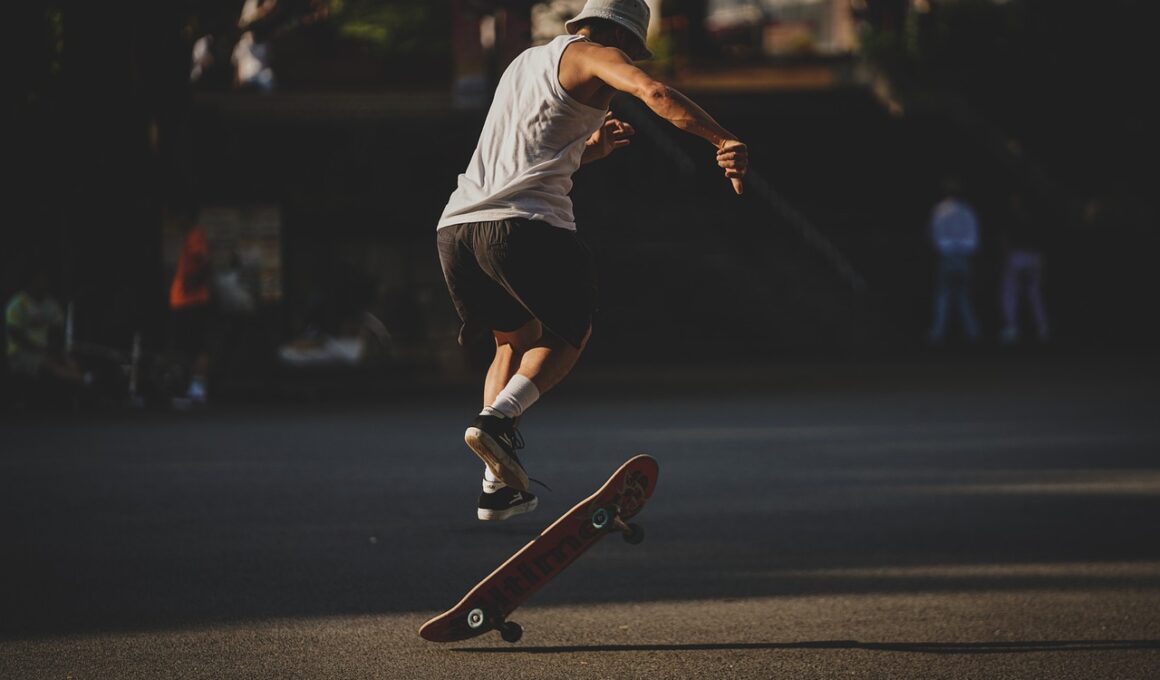Street Skateboarding Safety: Protect Yourself While Trying Tricks
Street skateboarding is an exhilarating yet challenging activity that can lead to serious injuries if proper safety measures are not implemented. Engaging in tricks such as ollies, kickflips, and grinds demands both skill and caution. To minimize risks, investing in quality protective gear is essential. Equip yourself with a sturdy helmet, wrist guards, knee pads, and elbow pads to help absorb some of the shocks from falls. Familiarizing yourself with your surroundings is equally crucial. Pay attention to the surface conditions and avoid obstacles like bumps or cracks that may cause a fall. Practicing in an appropriate area, such as a skate park or smooth street, will also improve safety. Be aware of pedestrians and vehicles while skating, as accidents can happen quickly. Always make sure you understand your limits and skill level before attempting advanced tricks. Sticking to your capabilities prevents injuries and promotes confidence. Whether you’re a beginner or a seasoned skater, remember that safety should always come first during your sessions. This mindset ensures that you can keep enjoying skateboarding without unnecessary risks in the process.
Alongside wearing protective gear, it’s vital to warm up your muscles before hitting the pavement. Stretching is an essential part of preparing for any physical activity, particularly street skating, where flexibility is key. Focus on areas like your legs, back, and shoulders to enhance mobility and reduce the risk of strains. Engaging in dynamic stretches, such as leg swings and arm circles, can effectively loosen your body. Additionally, practicing basic tricks slowly can help build both muscle memory and confidence. Once you feel adequately warmed up, gradually increase the intensity of your practice. If you find yourself frequently falling or struggling with a specific trick, consider breaking it down into smaller components. Concentrate on mastering each part before attempting the entire trick. This not only improves technique but also decreases the chance of injury. To further bolster safety, it’s wise to skate with friends. Having fellow skaters around means you can look out for one another and provide assistance if needed. Thus, street skateboarding should be a collective experience, focusing on fun and safety. By prioritizing these elements, you ensure enjoyable rides while safeguarding yourself and others on the streets.
Choose the Right Skateboard
Selecting the right skateboard is fundamental to executing tricks safely and effectively. Beginners should focus on getting a sturdy, well-constructed board, preferably around 7.5 to 8 inches wide. This size supports better stability, crucial for learning your first tricks. Material also plays a substantial role; for example, maple wood is the standard for durability. Furthermore, consider the type of wheels and trucks your skateboard has. Softer wheels (around 78A-87A) provide better grip and shock absorption—ideal for street surfaces. However, harder wheels (88A+) are preferred for smoother terrains. Trucks should be responsive yet comfortable, allowing for proper control while performing tricks. When considering your skateboard setup, ensure to take your height and weight into account. A setup that fits your stature can help with balance and control. Additionally, customizing your skateboard with personalized grip tape can enhance traction while offering a source of creative expression. The choice of color and design can motivate you to skate more often. Engaging with skilled skateboarders or local shops can provide access to valuable insights regarding materials and brands to explore. Finding the right skateboard will put you on track toward safer and more enjoyable trick sessions.
As you progress, developing a solid understanding of potential hazards is equally crucial for street safety. Urban environments present various risks, from curbs to traffic and crowds. One of the first steps is to scout locations meticulously. Before jumping into tricks, evaluate the terrain to identify any obstacles. Consider factors such as pedestrian traffic, nearby vehicles, and the layout of the space. For example, some areas have smooth concrete ideal for practicing, while others may have uneven pavement that could lead to falls. Establishing your session at less trafficked times can minimize disruptions, enhancing focus on trick execution. Another realization is that despite mastering a trick, the street offers unpredictable challenges that aren’t present in parks. External factors such as weather conditions can impact performance too, making slick surfaces or windy days particularly dangerous. Therefore, dedicating specific days to practice while observing the environment can lead to noticeable improvements. Additionally, carrying basic supplies like first aid kits can prepare you for minor injuries, allowing you to address them immediately. Street skating thrives on spontaneity, but safety must always remain the top priority.
Gradual Progression in Tricks
The journey of mastering street tricks requires patience and gradual progression. As a beginner, focus on fundamental tricks such as the ollie and shove-it. These provide a solid foundation upon which you can build more complex skills. Gradually introduce one new trick at a time, letting yourself become proficient before moving onward. Before attempting more advanced tricks like the heelflip or tre flip, ensure you can perform the basics comfortably. This ensures that your confidence remains high and minimizes the risk of falls. Moreover, consistency is key during practice sessions. Allocate time to skate regularly and work on your tricks to reinforce muscle memory effectively. Document your progress to track improvements; it could be beneficial. Set realistic goals for yourself and reward your achievements along the way, no matter how small. Achievements foster motivation and enthusiasm in skaters. Additionally, consider seeking constructive feedback from experienced skaters or coaches, as their observations can highlight nuances you might overlook. With gradual skill enhancement, improved stability, and safety awareness, you’ll progress significantly while minimizing the chances of injury on your street skating journey.
Equally important is to listen to your body and acknowledge your limits. As exciting as it is to push yourself and learn new tricks, health should always come first. Developing a trick without sufficient practice can lead to injuries or muscle fatigue, meaning recovery time increases. Ensure you get adequate rest between sessions, especially if you feel sore or tight. Being mindful of fatigue can play a vital role in avoiding accidents. Taking breaks may also prevent burnout, keeping your passion for skating alive and well. As you learn tricks, allowing time for recovery can aid muscle repair, enabling you to perform at peak levels in future sessions. Remember that every skater, regardless of experience, endures minor injuries. Staying mentally prepared for setbacks can ensure resilience on the skateboard. Embrace failures as a part of learning while remaining persistent in your practice. Furthermore, consider cross-training with activities like cycling or yoga, which can improve strength and flexibility, benefiting your skateboarding. Such practices allow you to become a more well-rounded skater, promoting both skill improvement and prevention of injuries. Balancing recovery with practice ensures longevity in your skating endeavors.
Community Connection and Safety Awareness
Finally, skaters should engage with their local community to foster a culture of safety awareness. Many skate parks organize events, workshops, and sessions that emphasize not only skill development but also safety practices. Participating in these community-driven events allows you to gain knowledge and share experiences with fellow skaters. Establishing friendships fosters a sense of belonging and encourages one another to skate responsibly. Collaborating with others encourages discussions about skateboard maintenance, gear recommendations, and safety protocols. Understanding local laws and regulations is beneficial as well. Street skating can sometimes intrude on private property, creating potential legal issues. Being informed about designated skating areas prevents unwanted confrontations. Additionally, local skate groups often communicate regarding challenging spots or hazardous areas to avoid. Keeping in touch with recent community updates helps keep everyone informed. During events or competitions, stay respectful of fellow skaters, ensuring everyone has the opportunity to practice their tricks safely. As skating grows in popularity, maintaining strong connections can pave the way for improved skate facilities and resources for everyone, leading to a safer and more vibrant skating culture in the long run.
In conclusion, street skateboarding is an immensely fun activity enjoyed by many, but safety should always be at the forefront of every skater’s mind. Incorporating proper safety gear, warming up, selecting the right skateboard, and gradually progressing through tricks are essential steps for avoiding injuries. These methods allow skaters to enjoy their passion while minimizing risks. Recognizing and understanding environmental hazards, listening to your body, and engaging with the local skating community further enhances experience and promotes safety awareness. Ultimately, creating a safe atmosphere benefits all skaters, enabling them to continuously push their limits and explore creativity on the board. Bumps and bruises are part of the journey; therefore, resilience and adaptability must prevail. Enhancing skating skills becomes more fulfilling when approached safely. By implementing these tips, skaters advance their abilities while enjoying the sport without fear. Remember, skateboarding is about having fun and expressing oneself creatively. Embrace the shared experiences and respect the culture that comes with it. Every skater contributes to the community, and together, we can foster positive change, encouraging responsible practices for generations of street skaters to come.


